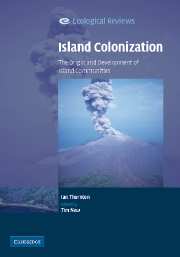Book contents
- Frontmatter
- Contents
- Editorial preface
- Acknowledgements
- PART I Theoretical and experimental studies
- PART II Natural recolonization after devastation
- PART III The recolonization of devastated islands
- PART IV Assembly of biotas on new islands
- 9 Lake Wisdom: a new island of fresh water
- 10 New islands in the sea
- 11 Anak Krakatau, Krakatau's child, b. 1933
- 12 Surtsey, Island of Surtur, b. 1963
- 13 Motmot: an emergent island in fresh water
- PART V Colonization and assembly
- References
- Index
10 - New islands in the sea
Published online by Cambridge University Press: 12 January 2010
- Frontmatter
- Contents
- Editorial preface
- Acknowledgements
- PART I Theoretical and experimental studies
- PART II Natural recolonization after devastation
- PART III The recolonization of devastated islands
- PART IV Assembly of biotas on new islands
- 9 Lake Wisdom: a new island of fresh water
- 10 New islands in the sea
- 11 Anak Krakatau, Krakatau's child, b. 1933
- 12 Surtsey, Island of Surtur, b. 1963
- 13 Motmot: an emergent island in fresh water
- PART V Colonization and assembly
- References
- Index
Summary
Sand cays in the Coral Sea and on the Puerto Rico Bank
In their studies of community assembly, Heatwole (1971, 1981) and Heatwole and Levins (1972a, 1973) have taken sand cays as their study units, to good effect.
Heatwole (1971) examined 12 bare cays of the Great Barrier Reef and adjacent areas of the Coral Sea, north-east of Australia. He found that although the cays were at least 200 km from the mainland and quite devoid of vegetation, all of them contained terrestrial invertebrate animals.
Heatwole was able to record a number of instances of dispersal. Only one moth (a microlepidopteran) was found on these plantless cays, clearly an unestablished immigrant; an individual of the same species was seen at sea 3 km from the cay. On one cay the empty pupal cases of a large fly testified to another colonization attempt. On another, only a single centipede was found, and this on the beach beneath a washed-up coconut with a crack in its husk, in which the centipede may have survived the sea journey.
The sequence of colonization followed on the bare cays was the same as that outlined by Dammerman on Krakatau (Chapter 8), with scavengers and detritivores exploiting ocean-derived food and forming the base of the islands' own trophic webs. There was a high rate of turnover and the numbers of species present on the islands were related to island area, height and use by sea birds, which acted as conduits of energy from the ocean to the island by feeding on fish and contributing guano, their dead bodies as carrion, and occasionally regurgitated fish to the terrestrial island system.
- Type
- Chapter
- Information
- Island ColonizationThe Origin and Development of Island Communities, pp. 142 - 147Publisher: Cambridge University PressPrint publication year: 2007



